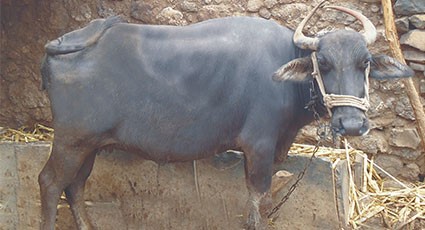Cattle and Buffalo Breeds
Choosing the Right Breed
- India has different types of cattle and buffalo breeds that are distributed across the country and agro-climatic conditions.
- While there is no ‘ideal breed’, choices are specific to the purpose they serve and to the farming environment, production system, breeding system and market requirements, and most importantly, the socio-economic status of the farmer.
- Broadly, the purpose of rearing dairy animals is for milk, draught (work) or for both (dual purpose). Dairy animals are also reared for dung (as manure), urine, etc.
- While choosing a breed, it is best to buy those from the home tracts or local farmers rearing that breed rather than bringing in a breed from afar.
- In general, cattle from drier regions are well built while those from heavy rainfall, coastal and hilly regions are smaller in build.
Selection of dairy cows
- Whenever an animal is purchased from a cattle fair, it should be selected based upon its breed characters and milk producing ability
- History sheet or pedigree sheet which are generally maintained in organized farms reveals the complete history of animal
- The maximum yields by dairy cows are noticed during the first five lactations. So generally selection should be carried out during first or second lactation and that too months after calving.
- Three successive complete milking has to be done and an average of it will give a fair idea regarding production by a particular animal.
- A cow should allow anybody to milk, and should be docile.
- It is better to purchase the animals during the months of October and November.
- Maximum yield is noticed till 90 days after calving.
Following guidelines will be useful for selection of a diary cow.
Breed characteristics of high yielding dairy cows
- Attractive individuality with feminity, vigour, harmonious blending of all parts, impressive style and carriage
- Animal should have wedge shaped appearance of the body
- It should have bright eyes with lean neck
- The udder should be well attached to the abdomen
- The skin of the udder should have a good network of blood vessels
- All four quarters of the udder should be well demarcated with well placed teats.
Indigenous Cattle Breeds
The cattle breeds are divided into milch purpose, dual purpose and draught animal depending on the major purpose they serve.
1.Indigenous dairy breeds of cattle
- This breed is otherwise known as Bhadawari, Desan, Gujarati, Kathiawari, Sorthi, and Surati.
- Originated in Gir forests of South Kathiawar in Gujarat also found in Maharashtra and adjacent Rajasthan.
- Gir is a world-renowned breed known for its tolerance to stress conditions.
- It has the capacity for yielding more milk with less feeding and is resistant to various tropical diseases.
- Basic colours of skin are white with dark red or chocolate-brown patches or sometimes black or purely red.
- Horns are peculiarly curved, giving a ‘half moon’ appearance.
- Milk yield ranges from 1200-1800 kgs per lactation.
- Age at first calving 45-54 months and inter calving period from 515 to 600 days.
Gir

Gir Cattle
Red Sindhi
- This breed is otherwise called as Red Karachi, Sindhi, Malir and Mahi.
- Originated in Karachi and Hyderabad (Pakistan) regions of undivided India and also reared in certain organized farms in our country.
- Colour is red with shades varying from dark red to light, strips of white.
- Milk yield ranges from 1250 to 1800 kg per lactation.
- Age at first calving 39-50 months and inter calving period from 425-540 days.
- These are kept under intensive management conditions at organised farms.
- Bullocks despite lethargic and slow can be used for road and field work.

Red Sindhi Cattle
Sahiwal
- Originated in Montgomery district of Punjab.
- This breed otherwise known as Lola (loose skin), Lambi Bar, Montgomery, Multani, Teli.
- The best indigenous dairy breed. It is being utilized for improvement of local stock.
- The colour is reddish dun or pale red, sometimes flashed with white patches.
- Heavy breed with symmetrical body having loose skin.
- The average milk yield of this breed is between 1400 and 2500 kg per lactation.
- Age at first calving ranges from 37 to 48 months and the calving interval is 430 to 580 days.

Sahiwal
Rathi
- Originated from the mixture of Sahiwal, Red Sindhi, Tharparkar and Dhanni breeds apparently with a preponderance of Sahiwal blood.
- Particularly concentrated in Loonkaransar tehsil of Bikaner district which is also known as Rathi tract.
- The breed is well adapted to desert conditions.
- The average milk yield of this breed is between 1000 and 2800 kg per lactation.
- Age at first calving ranges from 36 to 52 months and the calving interval is 425 to 600 days.

Rathi Cattle
Shweta Kapila
- This breed is otherwise known as Gaunthi/Gavthi dhavi
- Originated in North Goa.
- Adapted to hot and humid weather
- The average milk yield of this breed is between 350 and 650 kg per lactation.
- Age at first calving ranges from 35 to 58 months and the calving interval is 395 to 520 days.

Shweta Kapila
2.Indigenous Draught breeds of cattle
Hallikar (Myosre)
- Originated from the former princely state of Vijayanagarm, presently part of Karnataka.
- The colour is grey or dark grey.
- They are compact, muscular and medium size animal with prominent forehead, long horns and strong legs.
- The breed is best known for its draught capacity and especially for its trotting ability.

Hallikar
Amritmahal (Doddadana, Jawari Dana, Number Dana)
- The Maharajas of Mysore developed this breed.
- Bullocks are specially suited for trotting and quick transportation.
- Amiritmahals are grey cattle but their shade varies from almost white to near black.
- The muzzle, feet and tail are usually black.
- Horns are long and end in sharp black points.
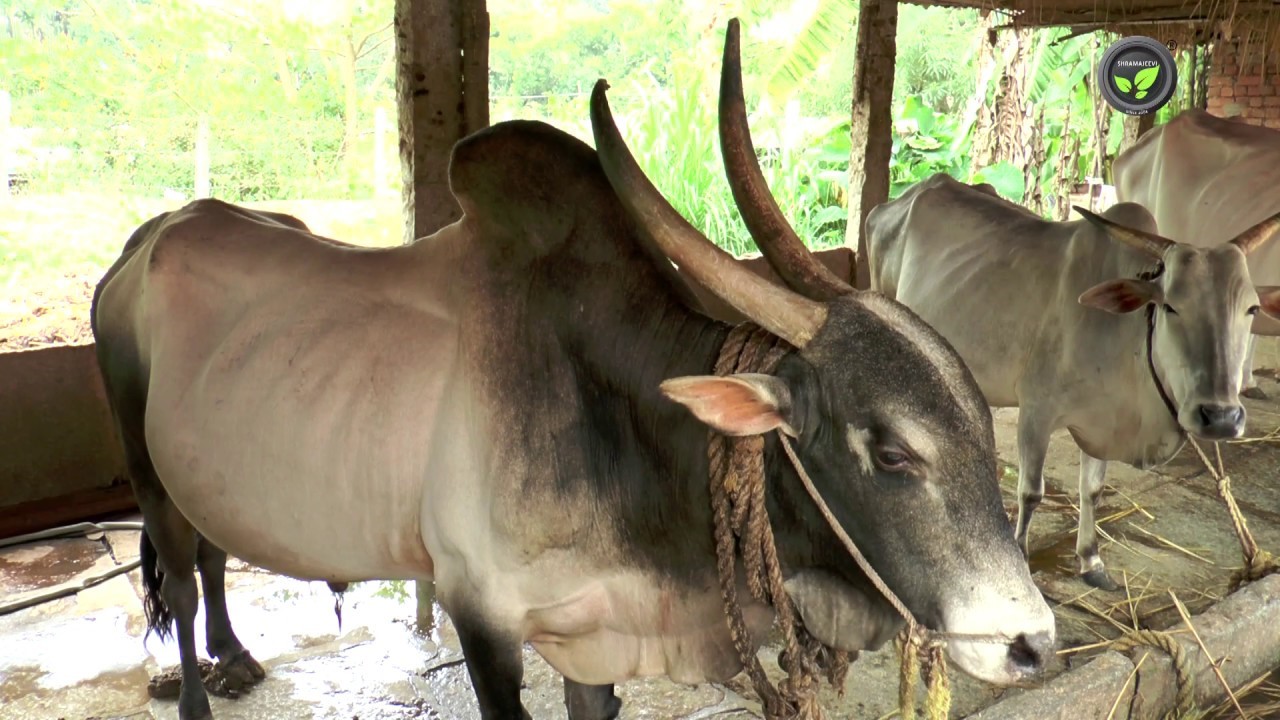
Amritmahal
Khillari (Mandeshi, Shikari, Thillar)
- Originated from Sholapur and Sitapur districts of Maharashtra.
- Closely resembles Hallikar breed.
- Grey-white in colour. New borns have dusty red colour which disappears in couple of months.
- Long horns turn forwards in a peculiar fashion. The horns are generally black, sometimes pinkish.
- Bullocks are fast, known for quick draught capability and powerful.
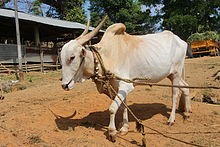
Khillari
Kangayam
- Also known as kongu and konganad.
- Originated in Kangayam, Dharapuram, Perundurai, Erode, Bhavani and Coimbatore district.
- Coat is red at birth, but changes to grey at about 6 months of age.
- Bullocks have a good capacity for work and are used for all agricultural operations.
- Transporation capacity of these bullocks is the main source of livelihood of their owners in and around sugar mills in this region.
- Moderate size with compact bodies.
Bargur
- Found around Bargur hills in Bhavani taluk of Erode district.
- Developed for work in uneven hilly terrains.
- Bargur cattle are of brown colour with white markings. Some white or dark brown animal are also seen.
- Animals are well built, compact and medium in size.
- Known for their speed and endurance in trotting.
- Cautious in behaviour and tends to remain away from strangers.
Umblachery
- It is otherwise called as Jathi madu, Mottai madu, Molai madu, Therkathi madu.
- Originated in Thanjavur, Thiruvarur and Nagappattinam districts of Tamil Nadu.
- Suitable for wet ploughing and known for their strength and sturdiness.
- Umbalachery breed being light in weight is very well suited for working in the alluvial type of soil available in this area.
- The practice of dehorning of bullocks is peculiar in Umblachery cattle. Unlike in other breeds the bullocks are dehorned.
Pulikulam
- This breed is commonly seen in cumbum valley of Madurai district in Tamilnadu.
- Also known as Jallikattu madu, kidai madu, sentharai.
- Small in size, usually grey or dark grey with farm markings.
- Well- developed hump.
- Mainly used for penning in the field. Pulikulam cattle are trained for riding events (Jallikattu).
- Useful for ploughing.
- Presence of reddish or brownish spots in muzzle, eyes, switch and back is the characteristic feature of this breed.
| Breed | Breeding tract | Important features |
|---|---|---|
| Bachaur (Bhutia) | Bihar | Known for draught qualities and ability to thrive on poor fodder resources. |
| Dagri(Gujarat Malvi) | Gujarat | Mainly for draught purpose. However, it gives less amount of milk. |
| Ghumusari | Odisha | Draftabililty of these bullocks is superior to that of other types of bullocks in the native tract. |
| Kangayam (Kanganad,Kongu) | Tamilnadu | Transporation capacity of these bullocks is the main source of livelihood of their owners in and around sugar mills in this region. |
| Kenkatha (Kenwaria) | Uttar Pradesh, Madhya Pradesh | They thrive on poor feed and fodder resources. Very popular for light draught on road and for cultivation. |
| Kherigarh (Kheri, Kharigarh, Khari) | Uttar Pradesh | Animals are resistant to diseases and the expenditure on treatment is almost nil. Bullocks are very good for draught purposes. They run very fast. |
| Malvi (Mahadeo puri, Manthani) | Madhya Pradesh | Well known for quick transportation, endurance and ability to carry heavy load on rough roads. |
| Mewati (Kosi and Mehwati) | Haryana, Rajasthan and Uttar Pradesh | These are powerfull and docile, and are useful for heavy ploughing, carting and drawing water from deep wells. |
| Nagori | Rajasthan | They are capable of heavy draught work in deep sand. This characteristic has given the breed its agility and case of movement. |
| Nimari (Khargaon, Khargoni, Khurgoni) | Madhya Pradesh | Used for all agricultural operations as well as for transportation |
| Ponwar (Purnea) | Uttar Pradesh | Move in groups putting their heads in between each other. Animals behave just like semi-wild type and are very difficult to handle. |
| Pulikulam (Palingu maadu, Mani maadu, Jallikattu maadu) | Tamilnadu | Pulikulam cattle are trained for riding events (Jallikattu) which is very popular game. Milking is done only in 10-15 cows in a herd to meet the requirements of herdsmen. |
| Red Kandhari (Lakhalbundavi) | Maharashtra | Bullocks are used for heavy work. |
| Siri | West Bengal, Sikkim | Bullocks are the only source of draught power. |
| Thutho (Ameshi, Sheapi, Chokru, Tseso) | Nagaland | Well adapted to hilly region and able to graze on hill slopes even during rainfall. |
3.Indigenous Dual purpose breeds of Cattle
Tharparkar
- Originated in Tharparkar district (Pakistan) of undivided India and also found in Rajasthan.
- Otherwise known as White Sindhi, Gray Sindhi and Thari.
- They are medium sized, compact and have lyre-shaped horn.
- Body colour is white or light grey.
- The bullocks are quite suitable for ploughing and casting and the cows yield 1800 to 2600 kg of milk per lactation.
- Age at first calving ranges from 38 to 42 months and inter calving period from 430 to 460 days.
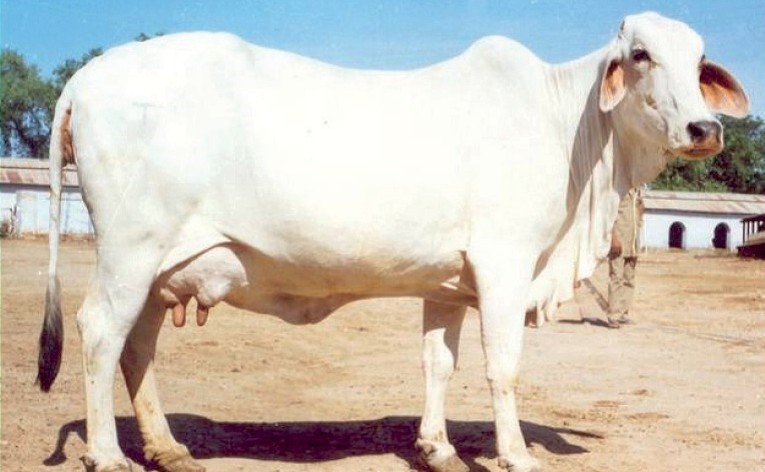
Tharparkar
Hariana
- It was originated from Rohtak, Hisar, Jind and Gurgaon districts of Haryana and also popular in Punjab, UP and parts of MP.
- Horns are small.
- The bullocks are powerful work animals.
- Hariana cows are fair milkers yielding 600 to 800 kg of milk in lactation.
- The age at first calving is 40 to 60 months and calving interval is 480 to 630 days.
Kankrej
Ongole
- Otherwise known as Nellore.
- Home tract is Ongole taluk in Guntur district of Andhra Pradesh.
- Large muscular breed with a well developed hump.
- Suitable for heavy draught work.
- White or light grey in colour.
- Average milk yield is 1000 kg per lactation. Age at first calving is 38 to 45 months and the intercalving period is 470 days.
- Exported to south East Asian and American countries for development of meat cattle.
Krishna Valley
- Originated from black cotton soil of the water shed of the river Krishna in Karnataka and also found in border districts of Maharastra.
- Animals are large, having a massive frame with deep, loosely built short body.
- Tail almost reaches the ground.
- Common colour grey white with a darker shade on fore quarters and hind quarters in male. Adult females are more whitish in appearance.
- The bullocks of this breed are powerful animals useful for slow ploughing, and valued for their good working qualities.
- The cows are fair milkers, average yield being about 900 kg per lactation.
- This is a heavy draught breed and used exclusively in the black cotton soil of the watershed of river Krishna.
Deoni
- breed is also known as Dongerpatti, Dongari, Wannera, Waghyd, Balankya, Shevera.
- Originated in Deoni Taluk of Maharashtra and is spread across Western Andra Pradesh and also found in Marathwada region of Maharashtra state and adjoining parts of Karnataka.
- Body colour is usually spotted black and white.
- Age at first calving ranges from 894 to 1540 days.
- Milk yield ranges from 636 to 1230 kg per lactation.
- Caving interval averages 447 days.
- Bullocks are suitable for heavy cultivation.
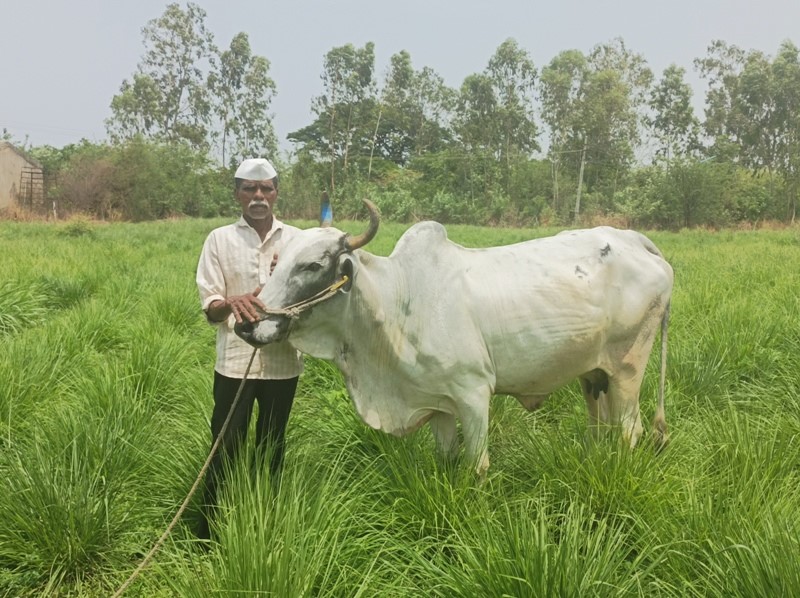
Deoni cattle
| Breed | Breeding tract | Important features |
|---|---|---|
| Ladakhi | Jammu & Kashmir | In spite of extreme climatic conditions, subsistence on poor quality feed and low availability of water, it produces around 2 to 5 kg of milk per day |
| Badri(Pahadi) | Uttarakhand | Well adapted to hilly terrains and climatic conditions. Balanced gait while walking. |
| Belahi (Morni) | Haryana and Chandigarh | Gujjars known as Langarias, are maintaining the breed for generations |
| Binjharpuri | Orissa | Used for Milk, Draught and Manure |
| Dangi (Kandadi) | Maharashtra and Gujarat | The breed is well known for its excellent working qualities in heavy rainfall areas, rice fields and hilly tracts. |
| Gangatiri (Eastern Hariana/Shahabadi) | Uttar Pradesh and Bihar | Medium milk producer and possess good draftability |
| Gaolao (Arvi, Gaulgani) | Madhya Pradesh | This is a fast trotting type breed suitable for quick transportation in hilly areas. |
| Himachali Pahari (Gauri, Himdhenu) | Himachal Pradesh | Moderate draught performance, Capability to work on narrow, sloppy, undulating , hill terrain |
| Khariar | Odisha | Basically a draft breed |
| Konkan Kapila (Konkan gidda) | Maharashtra | Low milk producer and possess good draft ability suited to hilly terrain and hot and humid climate |
| Kosali | Chhattisgarh | Bullocks of this breed are very efficient for paddy field operation (Beeashi) after sowing. |
| Lakhimi | Assam | Bullocks are excellent draft animals for carting and ploughing especially in the muddy fields for paddy cultivation.The milk produced by Lakhimi cattle is rich in fat for which it fetches a high price. |
| Malnad Gidda (Gidda, Uradana Varshagandhi) | Karnataka | Reared under low input low output system. Elite cow give 3-5 kg of milk per day despite small body size. These animals are highly adapted to harsh climatic conditions including heavy rainfall conditions. |
| Motu | Odisha | Cow dung is considered as important product from rearing of these cattle among the Koya tribes. |
| Nari (Sirohi) | Gujarat and Rajasthan | Medium to moderate in milk yield. Excellent draught power as they perform well in both plains & hilly forest areas |
| Poda Thurpu | Telangana | Bullock are preferred in both dryland and wetland agriculture and have excellent draught power in terms of endurance, speed & stamina. |
| Punganur | Andhra Pradesh | Dwarf cattle, These animals are used for agricultural operations on light soil. Bullocks are used for carts like tongas and for special races. |
| Vechur | Kerala | Milk production is relatively higher in this |
Crossbreed Dairy Cattle
- Dairy animals can be either indigenous or crossbred.
- While indigenous cattle attain puberty late, are mostly dual purpose and yield less milk, crossbred ones attain early puberty and are mostly milch breeds with high milk yields.
- Indigenous breeds have a low feed conversion ratio, require less investment and are more disease resistant while crossbred ones have a high feed conversion ratio, call for high investment, are more susceptible to diseases and require greater scientific management.
- Indigenous rather than crossbred breeds are preferred for arid and semi-arid regions.
Jersey
- It is developed in the Jersey Island, U.K.
- It is the smallest of the dairy types of cattle.
- In India this breed has acclimatized well and is widely used in cross breeding with indigenous cows.
- The typical colour of Jersey cattle is reddish fawn.
- Dished fore head and compact and angular body.
- These are economical producers of milk with 4.5% fat.
- Average milk yield is 4500 kg per lactation.
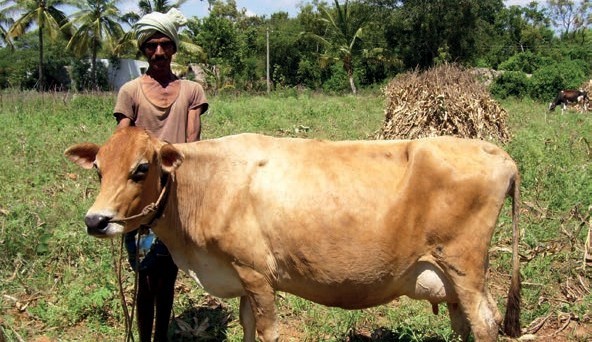
Jersey
Holstein Friesian
- This breed was developed in the northern parts of Netherlands, especially in the province of Friesland.
- They are ruggedly built and they possess large udder.
- They are the largest dairy breed and mature cows weigh as much as 700kg.
- They have typical marking of black and white that make them easily distinguishable.
- The average production of cow is 6000 to 7000 kg per lactation. However, the fat content in their milk is rather low (3.45 per cent).
- Age at first calving is 29 to 30 months and calving interval is 13 to 14 months.
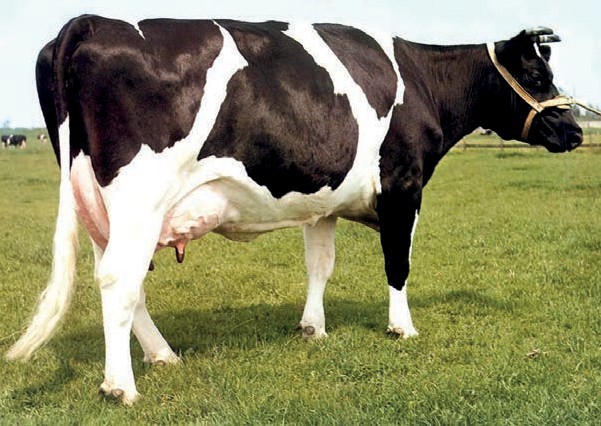
Holstein Friesian
Brown Swiss
- The mountainous region of Switzerland is the place of origin of Brown Swiss breed.
- It is famous in its home tract for its rugged nature and good milk production.
- Average milk yield is 5000 kg per lactation with 4% fat.
- The Karan Swiss is the excellent crossbred cattle obtained by crossing this breed with Sahiwal cattle at NDRI, Karnal.
- Age at first calving is 28 to 30 months and calving interval is 13 to 14 months.
Red Dane
- Developed in Denmark.
- The typical body colour of this Danish breed is red, reddish brown or even dark brown.
- It is also a heavy breed; mature males weighing up to 950 kg and mature female weigh 600 kg.
- The lactation yield of Red Dane cattle varies from 3000 to 4000 kg with a fat content of 4 per cent and above.
- Age at first calving is 28 to 30 months and calving interval is 13 to 14 months.
Ayrshire
- Origin Ayrshire in Scotland is considered as most beautiful dairy breed. These are very active animals but hard to manage.
- They do not produce as much milk or butter fat (only 4%) as some of the other dairy breeds.
- The breed was also known as Dunlop cattle or Cunningham cattle.
Guernsey
- Originated from Small island of Guernsey in France.
- Cherry red to brown in colour. Mahagony and white is a variation in colour.
- The milk has a golden colour due to an exceptionally high content of beta carotene which may help to reduce the risks of certain cancers.
- The milk also has a high butterfat content of 5% and a high protein content of 3.7%.
- Guernsey cows produce around 6000 kg per lactation.
- The Guernsey cow has many notable advantages for the dairy farmer over other breeds includes high efficiency of milk production, low incidence of calving difficulty and longevity.
2c. Buffalo Breeds
The present day domesticated buffaloes are the descendants of Bos arni found in wild state even today in north-eastern parts of India specially Assam and the surrounding areas. The buffaloes are normally classified into river ad swamp types though both are called Bubalus bublis. Most of the animals in India re river type though swamp type are also found in certain parts of the country specially in eastern parts of India.
India is considered as the home tract of some of the best buffalo breeds. Because of preference of buffaloes for milk, many she buffaloes from the breeding tract are moved to the thickly populated urban and industrial centre for meeting the milk requirements of this population. Indian buffaloes are in important source of milk supply today and yield nearly three times as much milk as cows. More than half of the total milk produced (55%) in the country was contributed by the 47.22 million milch buffaloes, where as the 57.0 million cows contribute only 45% of the total milk yield. Indian Buffaloes are water buffaloes. There are about 16 indigenous standard breeds of buffaloes, which are well known for their milking qualities.
Murrah
- It is also called as Delhi, Kundi, Kali
- It is the most important breed of buffaloes whose home is Rohtak, Hisar and Jind of Haryana and Nabha and Patiala districts of Punjab.
- The colour is usually jet black with white markings on tail and face and extremities sometimes found.
- The tightly curved horn is an important character of this breed.
- The body size is massive, neck and head are comparatively long.
- Head of females is short, fine and clear cut.
- Hips are broad and fore and hind quarters are drooping.
- The buffalo cows of this breed are one of the most efficient milk and butter fat producers in India.
- Butter fat content is 7% Average lactation yield is vary from 1500-2500 kg the average milk yield is 6.8 kg/day.
- While a few individual animals yield much as 19.1 kg/day.
- Age at first calving is 45-50 months and inter calving period is 450-500 days.
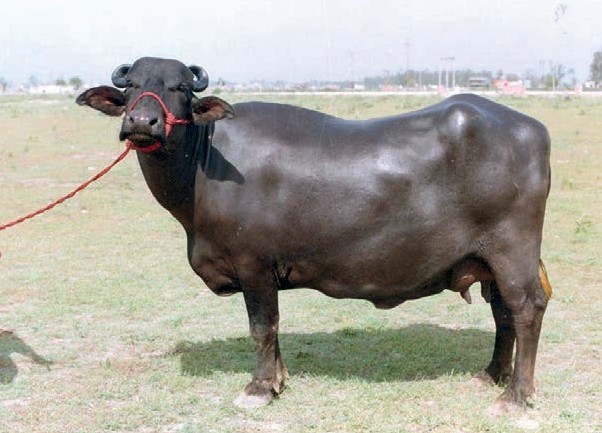
Murrah
Nili Ravi
- This breed is found in Sutlej valley in Ferozpur district of Punjab and in the Sahiwal district of Pakistan. (bred around Ravi river)
- Usually the colour is black with white marking on forehead, face, muzzle, legs and tail.
- The most desired character of the female is the possession of white markings.
- The head is elongate, bulging at top and depressed between eyes. The muzzle is fine.
- The frame is medium sized.
- The peculiarity of the breed is the wall eyes.
- The horns are small and coiled tightly. The neck is long, thin and fine.
- The milk yield is 1500-1850 kg per lactation and the inter calving period is 500-550 days.
- Age at first calving is 45-50 months.
Bhadawari
- Agra and Etawah district of Uttar Pradesh and Gwalior district of Madhya Pradesh.
- The body is medium size and wedge shaped. The head is comparatively small, the legs are short and stout, and the hooves are black. The hind quarters are uniform and higher than the forequarter.
- The body is usually light or copper coloured is a peculiarity of this breed. Eye lids are generally copper or light brown colour.
- Two white lines ‘Chevron’ are present at the lower side of the neck similar to that of surti buffaloes.
- Horns are black, curling slightly outward, downward before running backward parallel and close to neck, and finally turning upward.
- The average milk yield is 800 to 100 kg.
- The bullocks are good draught animal with high heat tolerance.
- The fat content varies from 6 to 12.5 per cent. This breed is an efficient converter of coarse feed into butterfat and is known for its high butter fat content.
Jaffarabadi
- These are massive animals found in their pure form in Gir forests. The breeding tract of this breed is Kutch, and Jamnagar districts of Gujarat.
- The head and neck are massive. The forehead is very prominent, wide with a slight depression in the middle.
- The horns are heavy, inclined to droop at each side of the neck and then turning up at point, but les tightly curved than in Murrah (drooping horns).
- The colour is usually black.
- The average milk yield is 100 to 1200 kg. These animals are mostly maintined by traditional breeders called Maldharis, who are nomads.
- The bullocks are heavy and used for ploughing and carting.
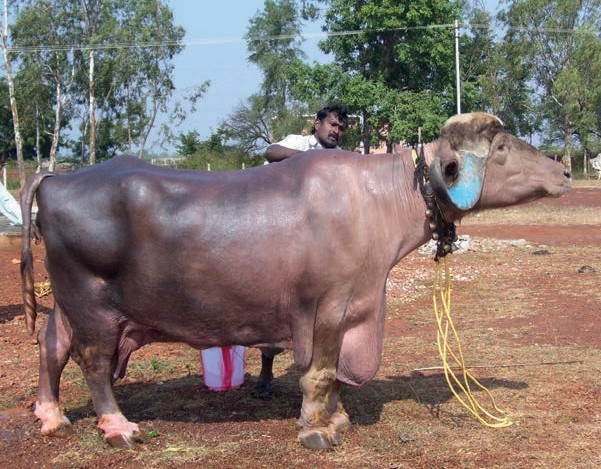
Jaffarabadi
Surti
- The breeding tract of this breed is Kaira and Baroda district of Gujarat.
- Coat colour varies from rusty brown to silver-grey. Skin is black or brown.
- The body is well shaped and medium sized; the barrel is wedge shaped.
- The head is long with prominent eyes.
- The horns are sickle shaped, moderately long and flat.
- The colour is black or brown
- The peculiarity of the breed is two white collars, one round the jaw and the other at the brisket.
- The milk yield ranges from 900 to 1300 kg.
- The age at first calving is 40-50 months with a intercalving period of 400-500 days.
- The peculiarity of this breed is very high fat percentage in milk (8-12per cent).
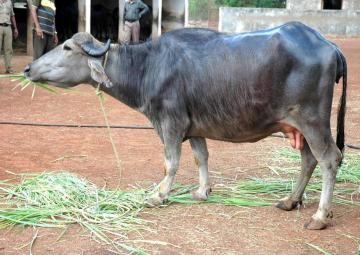
Surti Buffaloe
Mehsana
- Mehsana is a dairy breed of buffalo found in Mehsana town in Gujarat and adjoining Maharastra state.
- Body is mostly black; a few animals are black-brown in colour.
- The breed is supposed to have been evolved out of crossbreeding between the Surti and the Murrah.
- The body is longer than in Murrah and the limbs lighter.
- The head is longer and heavier.
- The horns usually are less curved at the end compared to Murrah breed but are longer and could be of irregular shape.
- The milk yield is 1200-1500 kg.
- The breed is supposed to have good persistency.
- The intercalving period ranges between 450-550 days.
Nagpuri (or) Ellichpuri
- The breeding tract of this breed is Nagpur, Akola and Amrawati districts of Maharashtra.
- These are black coloured animal with white patches on face, legs and tail.
- This is also called as Elitchpuri or Barari.
- The horns are long, flat and curved, bending backward on each side of the back almost to shoulder
- Horns of this type have a distinct advantage that they help the animals to protect themselves from wild animals and also easy to move in the forest.
- The face is long and thin. The neck is somewhat long.
- The average milk yield is 700-1200 kg per lactation.
- The age at first calving is 45-50 months with an inter-calving period of 450-550 days.
Godavari
- Godavari is a result of crossing of native buffaloes with Murrah bulls. The home tract is Godavari and Krishna deltaic area
- The animals are of medium stature with compact body. The colour is predominantly black with a sparse coat of coarse brown hair.
- Godavari buffaloes are reputed for high fat with daily average milk yield of 5-8 litres and lactation yield of 1200-1500 litres.
- The animals breed regularly and have a short calving interval compared to Murrah.
Toda
- Toda breed of buffaloes is named after an ancient tribe, Toda of Nilgiris of south India.
- Coat colour of the calf is generally fawn at birth.
- In adult the predominate coat colours are fawn and ash-grey.
- These buffaloes are quite distinct from other breeds and are indigenous to Nilgiri hills.
- The animals have long body, deep and broad chest, and short and strong legs.
- The head is heavy with horns set well apart, curving inward outward and forward.
- Thick hair coat is found all over the body. They are gregarious in nature.
Pandharpuri
- Native of Kolhapur, Solapur districts in south Maharashtra.
- Body colour varies from light black to deep black.
- It is medium sized animal having long narrow face, very prominent and straight nasal bone, comparatively narrow frontal bone and long compact body.
- Typical characteristic of this breed is its horns which are very long, curved backward, upward and usually twisted outwards. The horns are very long extending beyond shoulder blade, sometimes up to pin bones.
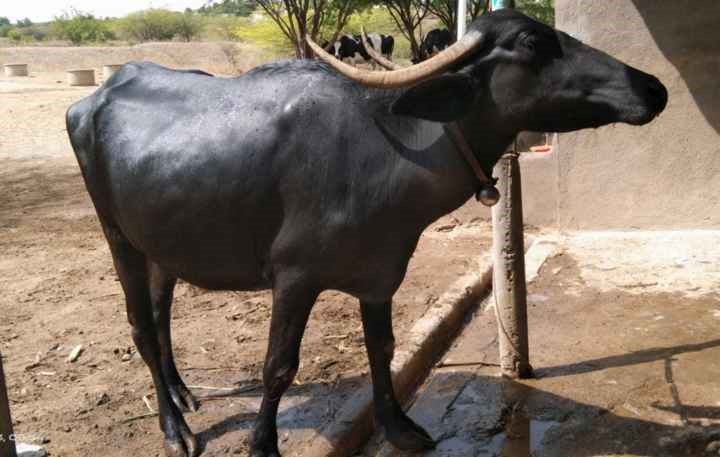
Pandharpuri
| Breed | Breeding tract | Important features |
|---|---|---|
| Marathwadi (Ellichpuri, Dudhana Thadi) | Maharashtra | Length of horns differentiates these buffaloes from Pandharpuri buffaloes. |
| Banni (Kutchi and Kundi) | Gujarat | Adapted to local climatic conditions and traditional extensive system of night grazing |
| Chilika (Deshi) | Orissa | The milk and curd of these buffaloes have better taste and preservation quality (curd for 5-7 days at room temperature). |
| Kalahandi | Odisha | Usually left loose in the morning and allowed to graze across forest, hillocks, roadside vegetation and harvested fields throughout the day. |
| Luit | (Assamese Swamp) | Assam and Manipur Bullocks are excellent draft animals for carting and ploughing specially in muddy field for paddy cultivation. |
| Bargur (Malai Erumai or Malai Emmai) | Tamil Nadu | Milk yield ranges from 1.5 to 2.0 liters per day, Milk is mainly used for house hold consumption as curd and butter milk. |
| Chhattisgarhi | Chhattisgarh | Chhattisgarhi buffalo bullocks are preferred for ploughing the rice fields (especially during monsoon). These buffalo are slow maturing animals and average milkers. ‘Peda’ made from milk of these buffaloes is famous milk product. |
| Gojri | Punjab and Himachal Pradesh | Plays a significant role in securing livelihood for Gujjars, and these buffaloes are considered as a symbol of wealth in their community |
| Dharwadi | Karnataka | Dharwadi is a medium sized buffalo with black coat colour. Udder is medium in size; teats are cylindrical in shape. It is reared mainly for milk purpose. Average lactation milk yield is 972 litre. Daily milk yield ranges from 1.5 to 8.7 litre. Average percentage of milk fat is 6.9. The milk is used for preparation of famous Dharwad Peda with GI tag. The animals are well suited for low rainfall areas. |
| Manda | Odisha | It is a sturdy buffalo, well adapted to hill ranges of Eastern Ghats and plateau of Koraput region of Odisha. Body colour is mostly ash grey and grey with copper coloured hairs. It is reared for draught, milk and manure. Daily milk production ranges between 1.2 to 3.7 kg. Average fat percentage in milk is 8.4. Manda buffaloes are reared mostly under extensive system. |
| Purnathadi | Maharashtra | These animals are medium in size, whitish to light brown, while the newborn calves generally have complete whitish coat. Patch of white hairs is present on forehead. The daily milk yield, lactation milk yield and fat percentage ranged from 1.1-5.5 kg, 353-1533 kg and 6.5-11.5, respectively. |
